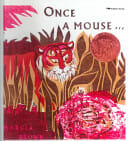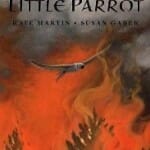 Countless animal fables are read each day in primary classrooms around America. If you’re looking for a fable that is rooted in ancient Indian culture consider- Once A Mouse … and/or The Brave Parrot.
Countless animal fables are read each day in primary classrooms around America. If you’re looking for a fable that is rooted in ancient Indian culture consider- Once A Mouse … and/or The Brave Parrot.
The timeless message from Once A Mouse. . . by Marcia Brown (Atheneum Books for Young Readers, 1961), a Caldecott winning book from the 1960s, remains relevant today. In simple language, Marcia retells an animal fable from the Hitopadesa, a collection of Sanskrit stories from the 12th century and illustrates with captivating wood cuttings. The main character, a hermit with magical powers, is able to transform a mouse into larger and larger animals. When the enlarged animal becomes ungrateful, the arrogant hermit is quick to return the animal back to his original stature. The actions of both are ripe for discussion.
Talking Points
- How folktales provide moral lessons
- Indian folklore
- Humility and generosity
- Gratefulness
- Tolerance and acceptance
- Bragging
- Compassion
- Foolishness and acting without thinking
Lifetime Honors for Marcia Brown
- Three Caldecott Medals
- Six Caldecott Honor awards
- Laura Ingalls Wilder Award.
Another layer of Sanskrit literature comes from a selection called Jataka tales. Some sources date these works to the 4th century BCE. These stories relate to the previous lives of Buddha in animal and human form. In the The Brave Little Parrot (G. P. Putnam’s Sons, 1998) Rafe Martin uses his words and Susan Gaber uses her dramatic illustrations to capture a modern interpretation of a Jataka story. A dull looking parrot is able to save a forest from a devastating fire by seeking the help of ancient gods and goddesses after the animal kingdom refuses to become involved as the fire grows stronger and stronger. The parrot’s virtues are visualized when his feathers undergo a metamorphosis by changing from gray to bold colors. The parrot’s ability to elicit support from one of the gods demonstrates a unique quality that can be appreciated by humans.
century BCE. These stories relate to the previous lives of Buddha in animal and human form. In the The Brave Little Parrot (G. P. Putnam’s Sons, 1998) Rafe Martin uses his words and Susan Gaber uses her dramatic illustrations to capture a modern interpretation of a Jataka story. A dull looking parrot is able to save a forest from a devastating fire by seeking the help of ancient gods and goddesses after the animal kingdom refuses to become involved as the fire grows stronger and stronger. The parrot’s virtues are visualized when his feathers undergo a metamorphosis by changing from gray to bold colors. The parrot’s ability to elicit support from one of the gods demonstrates a unique quality that can be appreciated by humans.
An animated version of the story can be seen at http://indigenouspeoplenet.blogspot.com/2012/04/brave-little-parrot.html
Talking Points
- Hidden messages in ancient literature
- Role of gods and goddesses in ancient cultures
- Comparing/contrasting cultures that believe in multiple gods and goddesses
- Courage
- Perseverance
- Choices
- Empowerment and fighting for what you belief in
Can the lessons learned from these fables be compared/contrasted to stories from other places?
Leave a Reply
You must be logged in to post a comment.